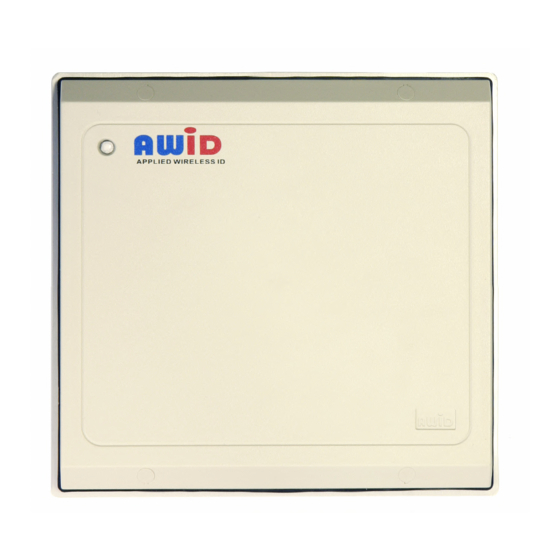Table of Contents
Advertisement
Quick Links
APPLIED WIRELESS ID
LR-911 LONG-RANGE READER AND PASSIVE TAGS
Part 2: INSTALLING THE PRODUCTS (Wiegand Interface)
These instructions describe the steps toward successful installation of AWID's long-range reader and tags.
The wiring diagrams for testing and installing the products are on pages 7 and 8.
Reference Material
•
PowerPoint presentation, "LR-911 Installation Practices and Procedures", on AWID's web site
(www.awid.com). Select "Download" on AWID's homepage. This is an informative and
important starting point to learn about the products and their installation.
•
"LR-911 Surveillance Zone Diagram"
•
"GMWS Glass-Mounted Windshield Tags - Instructions for Holding"
•
"Tags for Long-Range Readers - Location, Testing"
•
"Vehicle Mounting Recommendations" for WS tags and for MT tags
Products ............................................................................................page 2
Pre-Installation Testing.....................................................................page 3
Installing at the Site ..........................................................................page 4
Testing the Installation - Offline ......................................................page 6
Testing the Reader and Tags - Serial Interface to PC ......................page 6
Testing the Installation - Online.......................................................page 6
Fig. 1
Pre-Installation Testing, and Aiming the Reader..............................page 7
Fig. 2
Installing at the Site ..........................................................................page 8
Fig. 3
Serial Interface to PC........................................................................page 7
Applied Wireless Identifications Group, Inc.
382 Route 59, Section 292, Monsey, NY 10952 • Tel: 845-369-8800 • Fax: 845-369-1195
Instructions
CONTENTS
Advertisement
Table of Contents

Summary of Contents for AWID LR-911
- Page 1 LR-911 LONG-RANGE READER AND PASSIVE TAGS Part 2: INSTALLING THE PRODUCTS (Wiegand Interface) These instructions describe the steps toward successful installation of AWID’s long-range reader and tags. The wiring diagrams for testing and installing the products are on pages 7 and 8.
- Page 2 “Tags for Long-Range Readers – Location, Testing” “Vehicle Mounting Recommendations for WS Tag” “Vehicle Mounting Recommendations for MT Tag” Wiring – Good Practices Please observe these important suggestions when wiring the LR-911 reader – or any low-voltage products or systems. • Connect wires in this sequence: First ...
- Page 3 800-369-5533 (outside the United States, 845-369-8800). 2. Items for Bench Testing AWID’s long-range reader and tags are tested easily using only the items listed below. It is not necessary to interface the reader to a controller panel or reader-input module while conducting this test.
- Page 4 Watch the environment. Stay away from UHF communications devices. Avoid fluorescent lighting fixtures by 3 or 4 feet. Keep neighboring long-range readers on parallel lanes at least 12 feet apart, with their surveillance zones parallel. Do not have LR-911 readers facing each other (but “back-to-back” is OK).
- Page 5 Instructions LR-911, Part 2 14 September 2005 Page 5 of 8 3. Wiring the Reader Cable between the LR-911 reader and the controller panel should be – • • • 6 conductors Not twisted-pair * High quality • • •...
- Page 6 Attach the 9-pin “D” connector on the adapter cable to the PC’s serial input port. b. Connect the spring clips on the adapter cable to the wires on the LR-911 reader – Orange to Violet, Blue to Blue, and Violet to Orange.
- Page 7 1. Separate the unused wires. Keep the unused wires isolated. 2. On some earlier LR-911 readers, the spring clip on the orange wire of the test unit must connect to the reader’s violet wire. If the orange-to-orange connection does not work, use an orange-to-violet connection.
- Page 8 6. Power: Do not power the LR-911 reader from the reader port’s DC power terminal. Use an independent power supply for the readers – a linear regulated DC power supply, between 7 volts, 1.5 amperes and 15 volts, 0.75 ampere.












Need help?
Do you have a question about the LR-911 and is the answer not in the manual?
Questions and answers